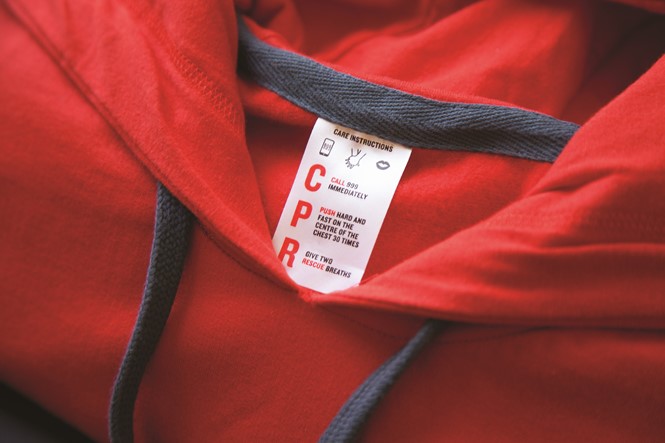Brand in Action: British Heart Foundation

Highlighting a core brand message on a physical garment allowed the British Heart Foundation to develop a new brand touchpoint
Who: British Heart Foundation and the Partners
What: The British Heart Foundation’s (BHF) annual ‘Wear It Beat It’ campaign encourages people to wear red shirts and donate to support the fight against heart disease all while raising awareness for cardiovascular disease. Each year, the charity calls upon its design and brand agency roster to create t-shirt designs for the campaign’s sales push. The Partners, which has been working with the BHF’s CPR team devised something a little different. It created a t-shirt care label that drives home the messaging around CPR – not just ‘cardiopulmonary resuscitation,’ but ‘care, push, rescue.’
How: “Everyone knows what CPR is, but no one actually knows what CPR is. It’s become unknown,” says Mark Wood, design director at the Partners. The consultancy has been working with the BHF to change the popular meaning of CPR to encourage people to recognise the actions to be taken in the event of a cardiac arrest or other emergency: call an ambulance, push hard on the chest and do rescue breathing.
Implementing the call to action on all ‘Wear It Beat It’ care labels, and now, across all BHF garments, was unexpected, but supports that communications strategy. The labels adopt the usage of standard care labels, but instead of information about how to wash the garment, it contains information about how to save lives. This relatively inexpensive two-coloured printed label will have an impact beyond its stature as it puts the CPR ‘rebrand’ in front of thousands – from ‘Wear It Beat It’ supporters to cyclists participating in the London to Brighton bike ride.
Why: “Call, push, rescue became the topline idea. Everyone knows CPR, but now they know it’s those words,” Wood says. The CPR labels are complemented by a major comms push that includes education in schools and workplaces, training kits and online video. “The reality is no one is ever going to think ‘That person’s had a heart attack, I’m going to check what to do on their t-shirt label.’ But it starts to build upon the message and that message is being understood. BHF could not have done it, but that would have been a missed opportunity to engage with someone,” Wood adds.












